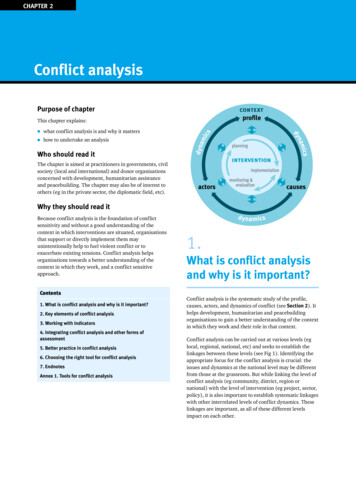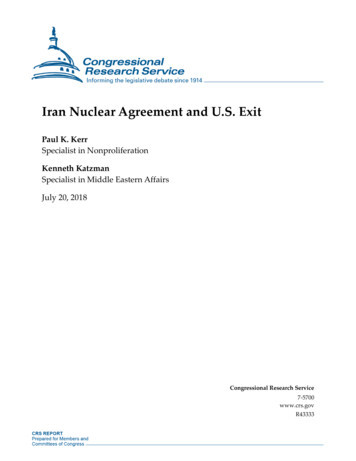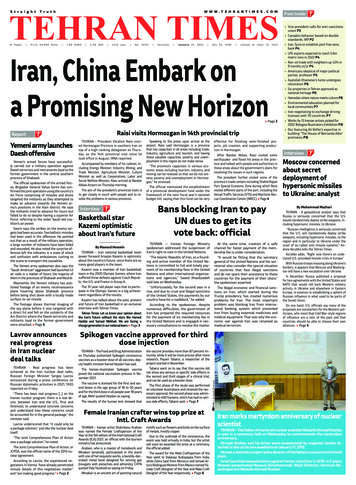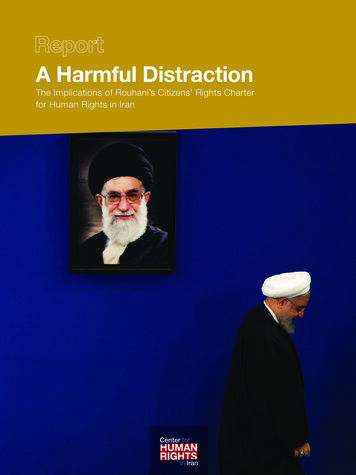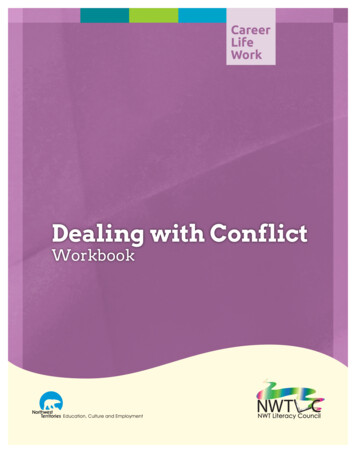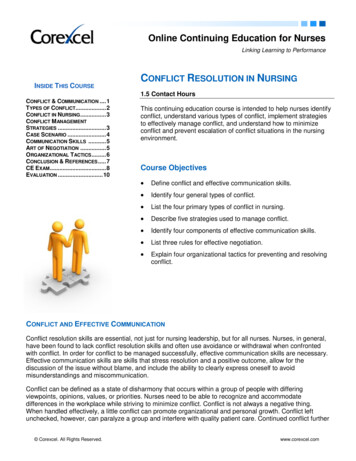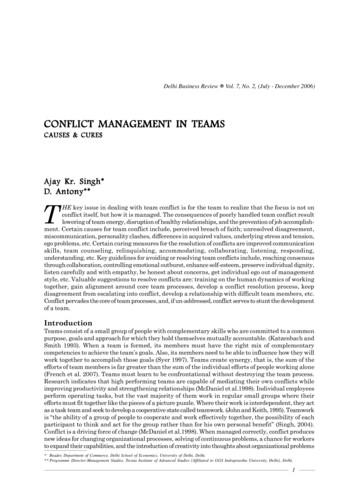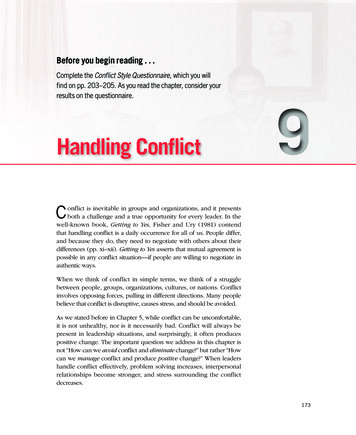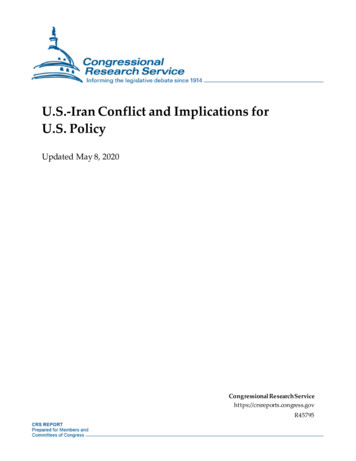
Transcription
U.S.-Iran Conflict and Implications forU.S. PolicyUpdated May 8, 2020Congressional Research Servicehttps://crsreports.congress.govR45795
SUMMARYU.S.-Iran Conflict and Implications forU.S. PolicySince May 2019, U.S.-Iran tensions have heightened significantly, and evolved into conflict afterU.S. military forces killed Qasem Soleimani, the commander of the Iran’s Islamic RevolutionaryGuard Corps-Quds Force (IRGC-QF) and one of Iran’s most important military commanders, ina U.S. airstrike in Baghdad on January 3, 2020. The United States and Iran have appeared to beon the brink of additional hostilities since, as attacks by Iran-backed groups on bases in Iraqinhabited by U.S. forces have continued.The background to the U.S.-Iran tensions are the 2018 Trump Administration withdrawal fromthe 2015 multilateral nuclear agreement with Iran (Joint Comprehensive Plan of Action, JCPOA),and Iran’s responses to the U.S. policy of applying “maximum pressure” on Iran. Since mid2019, Iran and Iran-linked forces have attacked and seized commercial ships, destroyed somecritical infrastructure in the Arab states of the Persian Gulf, conducted rocket and missile attackson facilities used by U.S. military personnel in Iraq, downed a U.S. unmanned aerial vehicle, andharassed U.S. warships in the Gulf. As part of an effort it terms “maximum resistance,” Iran hasalso reduced its compliance with the provisions of the JCPOA. The Administration has deployedadditional military assets to the region to try to deter future Iranian actions.R45795May 8, 2020Kenneth KatzmanSpecialist in MiddleEastern AffairsKathleen J. McInnisSpecialist in InternationalSecurityClayton ThomasAnalyst in Middle EasternAffairsThe U.S.-Iran tensions still have the potential to escalate into all-out conflict. Iran’s materiel support for armed factionsthroughout the region, including its provision of short-range ballistic missiles to these factions, and Iran’s network of agentsin Europe, Latin America, and elsewhere, give Iran the potential to expand confrontation into areas where U.S. responseoptions might be limited. Iran has continued all its operations in the region despite wrestling with the COVID-19 pandemicthat has affected Iran significantly. United States military has the capability to undertake a range of options against Iran, bothagainst Iran directly and against its regional allies and proxies. A September 14, 2019, attack on critical energy infrastructurein Saudi Arabia demonstrated that Iran and/or its allies have the capability to cause significant damage to U.S. allies and toU.S. regional and global economic and strategic interests, and raised questions about the effectiveness of U.S. defenserelations with the Gulf states.Despite the tensions and some hostilities with Iran since 2020 began, President Donald Trump continued to state that hispolicy goal is to negotiate a revised JCPOA that encompasses not only nuclear issues but also Iran’s ballistic missile programand Iran’s support for regional armed factions. High-ranking officials from several countries have sought to mediate to try tode-escalate U.S.-Iran tensions by encouraging direct talks between Iranian and U.S. leaders. President Trump has stated thathe welcomes talks with Iranian President Hassan Rouhani without preconditions, but Iran insists that the United States liftsanctions as a precondition for talks, and no U.S.-Iran talks have been known to take place to date.Members of Congress have received additional information from the Administration about the causes of the U.S.-Irantensions and Administration responses. They have responded in a number of ways ; some Members have sought to passlegislation requiring congressional approval for any decision by the President to take military action against Iran.Additional detail on U.S. policy options on Iran, Iran’s regional and defense policy, and Iran sanctions can be found in CRSReport RL32048, Iran: Internal Politics and U.S. Policy and Options, by Kenneth Katzman; CRS Report RS20871, IranSanctions, by Kenneth Katzman; CRS Report R44017, Iran’s Foreign and Defense Policies, by Kenneth Katzman; and CRSReport R43983, 2001 Authorization for Use of Military Force: Issues Concerning Its Continued Application, by Matthew C.Weed.Congressional Research Service
U.S.-Iran Conflict and Implications for U.S. PolicyContentsContext for Heightened U.S.-Iran Tensions . 1Iran’s Attacks on Tankers in mid-2019 . 2Actions by Iran’s Regional Allies . 3Tensions turn to Hostilities . 4Iran and U.S. Downing of Drones . 4UK-Iran Tensions and Iran Tanker Seizures . 4Attack on Saudi Energy Infrastructure in September 2019 . 5U.S. Sanctions Responses to Iranian Provocations . 6JCPOA-Related Iranian Responses . 7Conflict Erupts (December 2019-January 2020) . 8U.S. Escalation and Aftermath: Drone Strike Kills Qasem Soleimani . 9Iranian Responses and Subsequent Hostilities . 10Tensions Resurface in Spring 2020: Iraq and the Gulf . 11Efforts to De-Escalate Tensions . 12Iran-Focused Additional U.S. Military Deployments. 13Gulf Maritime Security Operation . 14U.S. Military Action: Options and Considerations . 14Resource Implications of Military Operations . 16Congressional Responses . 16Possible Issues for Congress. 19FiguresFigure 1. Selected Iran-supported Groups . 3Figure 2. Iran, the Persian Gulf, and the Region . 20Figure 3. Shipping Lanes in the Strait of Hormuz and Persian Gulf . 21ContactsAuthor Information . 22Congressional Research Service
U.S.-Iran Conflict and Implications for U.S. PolicyContext for Heightened U.S.-Iran TensionsU.S.-Iran relations have been mostly adversarial since the 1979 Islamic Revolution in Iran. U.S.officials and official reports consistently identify Iran’s support for militant armed factions in theMiddle East region a significant threat to U.S. interests and allies. Attempting to constrain Iran’snuclear program took precedence in U.S. policy after 2002 as that program advanced. The UnitedStates also has sought to thwart Iran’s purchase of new conventional weaponry and developmentof ballistic missiles.In May 2018, the Trump Administration withdrew the United States from the 2015 nuclearagreement (Joint Comprehensive Plan of Action, JCPOA), asserting that the accord did notaddress the broad range of U.S. concerns about Iranian behavior and would not permanentlypreclude Iran from developing a nuclear weapon. 1 Senior Administration officials explainAdministration policy as the application of “maximum pressure” on Iran’s economy to (1)compel it to renegotiate the JCPOA to address the broad range of U.S. concerns and (2) deny Iranthe revenue to continue to develop its strategic capabilities or intervene throughout the region. 2Administration officials deny that the policy is intended to stoke economic unrest in Iran. 3As the Administration has pursued its policy of maximum pressure, including imposing sanctionsbeyond those in force before JCPOA went into effect in January 2016, bilateral tensions haveescalated significantly. Key developments that initially heightened tensions include the following. On April 8, 2019, the Administration designated the Islamic Revolutionary GuardCorps (IRGC) as a Foreign Terrorist Organization (FTO),4 representing the firsttime that an official military force was designated as an FTO. The designationstated that “The IRGC continues to provide financial and other material support,training, technology transfer, advanced conventional weapons, guidance, ordirection to a broad range of terrorist organizations, including Hezbollah,Palestinian terrorist groups like Hamas and Palestinian Islamic Jihad, Kata’ibHezbollah in Iraq, al-Ashtar Brigades in Bahrain, and other terrorist groups inSyria and around the Gulf.Iran continues to allow Al Qaeda (AQ) operatives toreside in Iran, where they have been able to move money and fighters to SouthAsia and Syria.”5As of May 2, 2019, the Administration ended a U.S. sanctions exception for anycountry to purchase Iranian oil, aiming to drive Iran’s oil exports to “zero.”61For information on the JCPOA and the U.S. withdrawal, see CRS Report R43333, Iran Nuclear Agreement and U.S.Exit, by Paul K. Kerr and Kenneth Katzman.2Speech by Secretary of State Michael Pompeo, Heritage Foundation, May 21, 2018; T estimony of Ambassador BrianHook before the House Foreign Affairs Subcommittee on Middle East, North Africa, Hearing on U.S. -Iran Relations.June 19, 2019.3Speech by Secretary of State Pompeo, Heritage Foundation, op. cit.Statement from the President on the Designation of the Islamic Revolutionary Guard Corps as a Foreign T erroristOrganization, April 8, 2019.45Department of State, Office of the Spokesperson, Factsheet: Designation of the Islamic Revolutionary Guard Corps,April 8, 2019.6State Department Factsheet, April 22, 2019.Congressional Research Service1
U.S.-Iran Conflict and Implications for U.S. Policy Since May 2019, the Administration has ended five out of the seven waiversunder the Iran Freedom and Counter-Proliferation Act (IFCA, P.L. 112-239)—waivers that allow countries to help Iran remain within limits set by the JCPOA. 7 On May 5, 2019, citing reports that Iran or its allies might be preparing to attackU.S. personnel or installations, then-National Security Adviser John Boltonannounced that the United States was accelerating the previously planneddeployment of the USS Abraham Lincoln Carrier Strike Group and sending abomber task force to the Persian Gulf region. 8On May 24, 2019, the Trump Administration notified Congress of immediateforeign military sales and proposed export licenses for direct commercial sales ofdefense articles—training, equipment, and weapons—with a possible value ofmore than 8 billion, including sales of precision guided munitions (PGMs) toSaudi Arabia and the United Arab Emirates (UAE). In making the 22 emergencysale notifications, Secretary of State Pompeo invoked emergency authoritycodified in the Arms Export Control Act (AECA), and cited the need “to deterfurther Iranian adventurism in the Gulf and throughout the Middle East.”9 Iran’s Attacks on Tankers in mid-2019Iran responded to the additional steps in the U.S. maximum pressure campaign in part bydemonstrating its ability to harm global commerce and other U.S. interests and to raise renewedconcerns about Iran’s nuclear activities. Iran apparently has sought to cause international actors,including those that depend on stable oil supplies, to put pressure on the Trump Administration toreduce its sanctions pressure on Iran. On May 12-13, 2019, four oil tankers—two Saudi, one Emirati, and oneNorwegian ship—were damaged. Iran denied involvement, but a DefenseDepartment (DOD) official on May 24, 2019, attributed the tanker attacks to theIRGC. 10 A report to the United Nations based on Saudi, UAE, and Norwegianinformation found that a “state actor” was likely responsible, but did not name aspecific perpetrator. 11On June 13, 2019, two Saudi tankers in the Gulf of Oman were attacked.Secretary of State Michael Pompeo stated, “It is the assessment of the U.S.government that Iran is responsible for the attacks that occurred in the Gulf ofOman today .based on the intelligence, the weapons used, the level of expertiseneeded to execute the operation, recent similar Iranian attacks on shipping, andthe fact that no proxy group in the area has the resources and proficiency to actwith such a high degree of sophistication. ”127Letter from Mary Elizabeth T aylor, Assistant Secretary of State for Legislative Affairs, to Senator James Risch,Chairman of the Senate Foreign Relations Committee. May 3, 2019.8T he text of the announcement can be found at olton-2/.9 Letter from Secretary of State Michael R. Pompeo to Senate Foreign Relations Committee Chairman James E. Risch,May 24, 2019.10Department of Defense Briefing on Iran, May 24, 2019. For analysis on Saudi Arabia, see CRS Report RL33533,Saudi Arabia: Background and U.S. Relations, by Christopher M. Blanchard.1112Pamela Falk, “Oil tanker attack probe reveals new photos, blames likely ‘state actor,’” CBS News, June 7, 2019.Statement by the Secretary of State, June 13, 2019.Congressional Research Service2
U.S.-Iran Conflict and Implications for U.S. PolicyFigure 1. Selected Iran-supported GroupsSource: “Iran Military Power: Ensuring Regime Survival and Securing Regional Dominance,” Defense IntelligenceAgency (DIA), November 2019.Actions by Iran’s Regional AlliesIran’s allies in the region have been conducting attacks that might be linked to U.S.-Iran tensions,although it is not known definitively whether Iran directed or encouraged each attack (see Figure1 for a map of Iran-supported groups). Trump Administration officials, particularly Secretary ofState Pompeo, has stated that the United States will hold Tehran responsible for the actions of itsregional allies. 13 Some of the most significant actions by Iran-linked forces during mid-2019 arethe following: On May 19, 2019, a rocket was fired into the secure “Green Zone” in Baghdadbut it caused no injuries or damage. 14 Iran-backed Iraqi militias were widelysuspected of the firing and U.S. Defense Department officials attributed it toIran. 15 The incident came four days after the State Department ordered“nonemergency U.S. government employees” to leave U.S. diplomatic facilitiesin Iraq, claiming a heightened threat from Iranian allies. An additional rocket13Pompeo Warns Iran about T rigger for U.S. Military Action as Some in Administration Question Aggressive Policy.Washington Post, June 18, 2019.14For analysis on Iraq, see CRS Report R45025, Iraq: Background and U.S. Policy, by Christopher M. Blanchard.15Department of Defense Briefing on Iran. May 24, 2019, op. cit.Congressional Research Service3
U.S.-Iran Conflict and Implications for U.S. Policy attack launched from Iraq included a May 2019 attack on Saudi pipelineinfrastructure in Saudi Arabia with an unmanned aerial aircraft, first consideredto have been launched from Yemen. 16 Further attacks, discussed below, have ledto U.S.-Iran hostilities.In June 2019 and periodically thereafter, the Houthis, who have been fightingagainst a Saudi-led Arab coalition that intervened in Yemen against the Houthisin March 2015, claimed responsibility for attacks on an airport in Abha, insouthern Saudi Arabia, 17 and on Saudi energy installations and targets. TheHouthis claimed responsibility for the large-scale attack on Saudi energyinfrastructure on September 14, 2019, but, as discussed below, U.S. and Saudiofficials have concluded that the attack did not originate from Yemen.In a June 13, 2019, statement, Secretary of State Pompeo asserted Iranianresponsibility for a May 31, 2019, car bombing in Afghanistan that wounded fourU.S. military personnel. Administration reports have asserted that Iran wasproviding materiel support to some Taliban militants, but outside experts assertedthat the Iranian role in that attack is unlikely. 18Tensions turn to HostilitiesIn subsequent weeks, U.S.-Iran tensions erupted into direct hostilities as well as further Iranianactions against U.S. partners.Iran and U.S. Dow ning of DronesOn June 20, 2019, Iran shot down an unmanned aerial surveillance aircraft (RQ-4A Global HawkUnmanned Aerial Vehicle) near the Strait of Hormuz, claiming it had entered Iranian airspaceover the Gulf of Oman. U.S. Central Command officials stated that the drone was overinternational waters. 19 Later that day, according to his posts on the Twitter social media site,President Trump ordered a strike on three Iranian sites related to the Global Hawk downing, butcalled off the strike on the grounds that it would have caused Iranian casualties and therefore been“disproportionate” to the Iranian shoot down. 20 The United States did reportedly launch acyberattack against Iranian equipment used to track commercial ships. 21 On July 18, 2019,President Trump announced that U.S. forces in the Gulf had downed an Iranian drone viaelectronic jamming in “defensive action” over the Strait of Hormuz (see Figure 3). Iran deniedthat any of its drones were shot down.UK-Iran Tensions and Iran Tanker SeizuresU.S.-Iran tensions spilled over into confrontations between Iran and the UK. On July 4, 2019,authorities from the British Overseas Territory Gibraltar, backed by British marines, impoundedan Iranian tanker, the Grace I, off the coast of Gibraltar for allegedly violating an EU embargo onthe provision of oil to Syria. Iranian officials termed the seizure an act of piracy, and in“U.S. says Saudi pipeline attacks originat ed in Iraq: Wall Street Journal,” Reuters, June 28, 2019. For analysis on theYemen conflict, see CRS Report R43960, Yemen: Civil War and Regional Intervention, by Jeremy M. Sharp.161718Sadursan Raghavan, “Yemeni rebels claim new drone attack on Saudi airport,” Washington Post, June 17, 2019.“T he T aliban Claimed an Attack on U.S. Forces. Pompeo Blamed Iran,” Washington Post, June 16, 2019.19U.S. Central Command Statement . June 20, 2019.20President Donald T rump interview on “Meet the Press,” June 23, 2019.“U.S. Cyberattack made it Harder for Iran to T arget Oil T ankers.” New York Times, August 29, 2019.21Congressional Research Service4
U.S.-Iran Conflict and Implications for U.S. Policysubsequent days, the IRGC Navy sought to intercept a UK-owned tanker in the Gulf, the BritishHeritage, but the force was reportedly driven off by a British warship. On July 19, the IRGCNavy seized a British-flagged tanker near the Strait of Hormuz, the Stena Impero, claimingvariously that it violated Iranian waters, was polluting the Gulf, collided with an Iranian vessel, orthat the seizure was retribution for the seizure of the Grace I.On July 22, 2019, the UK’s then-Foreign Secretary Jeremy Hunt explained the government’sreaction to the Stena Impero seizure as pursuing diplomacy with Iran to peacefully resolve thedispute, while at the same time sending additional naval vessels to the Gulf to help secure UKcommercial shipping. On August 15, 2019, following a reported pledge by Iran not to deliver theoil cargo to Syria, a Gibraltar court ordered the ship (renamed the Adrian Darya 1) released.Gibraltar courts turned down a U.S. Justice Department request to impound the ship as a violatorof U.S. sanctions on Syria and on the IRGC, which the U.S. filing said was financially involvedin the tanker and its cargo. 22 The ship apparently delivered its oil to Syria despite the pledge23and, as a consequence, the United States imposed new sanctions on individuals and entities linkedto the ship and to the IRGC. On September 22, 2019, Iran released the Stena Impero.Separate from the UK-Iran dispute over the Grace I and the Stena Impero, Iran seized an Iraqitanker on August 5, 2019, for allegedly smuggling Iranian diesel fuel to “Persian Gulf Arabstates.”24Parallels to Past Incidents in the Gulf25Iran’s apparent attacks on tankers in May and June share some characteristics with events in the mid -to-late 1980sduring the 1980-1988 Iran-Iraq war. 1987-1988 represented the height of the “tanker war,” in which both Iran andIraq were attacking ships in the Gulf. The United States backed Iraq during that war, and sought to limit and deterIranian attacks on shipping, but there were several U.S.-Iran skirmishes in the Gulf. To protect commercialshipping, the United States launched “Operation Earnest Will” in July 1987, in which the United States reflagged 11of Kuwait’s oil tankers and the U.S. Navy escorted them through the Gulf. Almost immediately after the operationbegan, one of the tankers, the Bridgeton, was damaged by a large contact mine laid by Iran. In August 1987, U.S.forces captured the Iran Ajr, an Iranian landing craft being used for covert minelaying. However, Iran continuedattacking, including with missiles; on October 16, 1987, an Iranian Silkworm missile struck on a U.S.-flaggedKuwaiti tanker, Sea Isle City, 10 miles off Kuwait’s Al Ahmadi port. In response to that attack, U.S. destroyers andSpecial Operations forces blew up an Iranian oil platform east of Bahrain. On April 14, 1988, an Iranian -laid minestruck the U.S. frigate Samuel B. Roberts on patrol in the central Gulf, an attack that led to an April 16, 1988 , navalconfrontation in which the United States, in Operation Praying Mantis, put a large part of Iran’s naval force out ofaction, including sinking one of Iran’s two frigates and rendering the other inoperable. On July 3, 1988, mistaking itfor an attacking Iranian aircraft, the guided missile cruiser USS Vincennes shot down Iran Air commercial passengerflight 655, killing all aboard.Attack on Saudi Energy Infrastructure in September 2019 26Iran appeared to escalate tensions significantly by conducting an attack, on September 14, 2019,on multiple locations within critical Saudi energy infrastructure sites at Khurais and Abqaiq. The22“ Iran Warns U.S. Against Seizing Oil T anker Headed to Greece.” Bloomberg, August 18, 2019.23Iran T anker Unloaded its Cargo, T ehran Says. New York Times, September 10, 2019.“ Iran Reportedly Seizes Iraqi T anker In Persian Gulf.” NPR, August 5, 2019.24Much of this textbox is derived from Ronald O’Rourke, U.S. Naval Institut e Proceedings, “T he T anker War,” May1988; and CRS Issue Brief IB87145, “Persian Gulf: U.S. Military Operations,” January 19, 1989.2526For more detail, see CRS Insight IN11167, Attacks Against Saudi Oil Rattle Markets, by Michael Ratner, ChristopherM. Blanchard, and Heather L. Greenley and CRS Report RL33533, Saudi Arabia: Background and U.S. Relations, byChristopher M. Blanchard.Congressional Research Service5
U.S.-Iran Conflict and Implications for U.S. PolicyHouthi movement in Yemen, which receives arms and other support from Iran, claimedresponsibility but Secretary of State Pompeo stated: “Amid all the calls for de-escalation, Iran hasnow launched an unprecedented attack on the world’s energy supply. There is no evidence theattacks came from Yemen.”27 Press reports stated that U.S. intelligence indicates that Iran itselfwas the staging ground for the attacks, in which cruise missiles, possibly assisted by unmannedaerial vehicles, struck nearly 20 targets at those Saudi sites. 28 Iranian officials deniedresponsibility for the attack.The attack shut down a significant portion of Saudi oil production and, whether c onducted by Iranitself or by one of its regional allies, escalated U.S.-Iran and Iran-Saudi tensions anddemonstrated a significant capability to threaten U.S. allies and interests. President Trump statedon September 16, 2019, that he would “like to avoid” conflict with Iran and the Administrationdid not retaliate militarily. U.S. officials did announce modest increases in U.S. forces in theregion and some new U.S. sanctions on Iran.The attacks on the Saudi infrastructure raised several broad questions, including: What is the extent and durability of the long-standing implicit and explicit U.S.security guarantees to the Gulf states? Have Iran’s military technology capabilities advanced further than has beenestimated by U.S. officials and the U.S. intelligence community?U.S. Sanctions Responses to Iranian ProvocationsAs tensions with Iran increased, the Trump Administration increased economic pressure on Iranto weaken it strategically, and compel it to negotiate a broader resolution of U.S.-Iran differences. 27On May 8, 2019, the President issued Executive Order 13871, blocking U.S.based property of persons and entities determined to have conducted significanttransactions with Iran’s iron, steel, aluminum, or copper sectors. 29On June 24, 2019, President Trump issued Executive Order 13876, blocking theU.S.-based property of Supreme Leader Ali Khamene’i and his top associates.Sanctions on several senior officials, including Iran’s Foreign MinisterMohammad Javad Zarif, have since been imposed under that Order.On September 4, 2019, the State Department Special Representative for Iran andSenior Advisor to the Secretary of State Brian Hook said the United States wouldoffer up to 15 million to any person who helps the United States disrupt thefinancial operations of the IRGC and its Qods Force—the IRGC unit that assistsIran-linked forces and factions in the region. The funds are to be drawn from thelong-standing “Rewards for Justice Program” that provides incentives for personsto help prevent acts of terrorism.On September 20, 2019, the Trump Administration imposed additional sanctionson Iran’s Central Bank by designating it a terrorism supporting entity underExecutive Order 13224. The Central Bank was already subject to a number ofU.S. sanctions, rendering unclear whether any new effect on the Bank’s ability toSecretary Pompeo on T witter. 3:59 PM, September 14, 2019.U.S. T ells Saudi Arabia Oil Attacks Were Launched from Iran.” Wall Street Journal, September 16, 2019.T he text of the Order can be found at -aluminum-copper-sectors-iran/.2829Congressional Research Service6
U.S.-Iran Conflict and Implications for U.S. Policyoperate would result. Also sanctioned was an Iranian sovereign wealth fund, theNational Development Fund of Iran. In early 2020, U.S. officials indicated that they would use all available options toachieve an extension of the arms transfer ban on Iran provided by U.N. SecurityCouncil Resolution 2231, and which expires on October 18, 2020. U.S. officialsinsisted that the ban be extended in order to prohibit Russia and China fromproceeding with planned arms sales to Iran, which would have the effect ofincreasing the conventional military threat from Iran. See: CRS In FocusIF11429, U.N. Ban on Iran Arms Transfers, by Kenneth Katzman.JCPOA-Related Iranian Responses30Since the Trump Administration’s May 2018 announcement that the United States would nolonger participate in the JCPOA, Iranian officials repeatedly have rejected renegotiating theagreement or discussing a new agreement. Tehran also has conditioned its ongoing adherence tothe JCPOA on receiving the agreement’s benefits from the remaining JCPOA parties, collectivelyknown as the “P4 1.” On May 10, 2018, Iranian Foreign Minister Mohammad Javad Zarif wrotethat, in order for the agreement to survive, “the remaining JCPOA Participants and theinternational community need to fully ensure that Iran is compensated unconditionally throughappropriate national, regional and global measures.” He added thatIran has decided to resort to the JCPOA mechanism [the Joint Commission established bythe agreement] in good faith to find solutions in order to rectify the United States’ multiplecases of significant non-performance and its unlawful withdrawal, and to determinewhether and how the remaining JCPOA Participants and other economic partners canensure the full benefits that the Iranian people are entitled to derive from this globaldiplomatic achievement.Tehran also threatened to reconstitute and resume the country’s pre-JCPOA nuclear activities.Several meetings of the JCPOA-established Joint Commission since the U.S. withdrawal have notproduced a firm Iranian commitment to the agreement. Tehran has argued that the remainingJCPOA participants’ efforts have been inadequate to sustain the agreement’s benefits for Iran. InMay 8, 2019, letters to the other JCPOA participant governments, Iran announced that, as of thatday, Tehran had stopped “some of its measures under the JCPOA,” though the governmentemphasized that it was not withdrawing from the agreement. Specifically, Iranian officials saidthat the government will not transfer low enriched uranium (LEU) or heavy water out of thecountry in order to maintain those stockpiles below the JCPOA-mandated limits. A May 8, 2019,statement from Iran’s Supreme National Security Council explained that Iran “does not anymoresee itself committed to respecting” the JCPOA-mandated limits on LEU and heavy waterstockpiles.Beginning in July 2019, the International Atomic Energy Agency (IAEA) verified that some ofIran’s nuclear activities were exceeding JCPOA-mandated limits; the Iranian government hassince increased the number of such activities. Specifically, according to IAEA reports, Iran hasexceeded JCPO
U.S.-Iran Conflict and Implications for U.S. Policy Updated May 8, 2020 Congressional Research Service https://crsreports.congress.gov R45795
